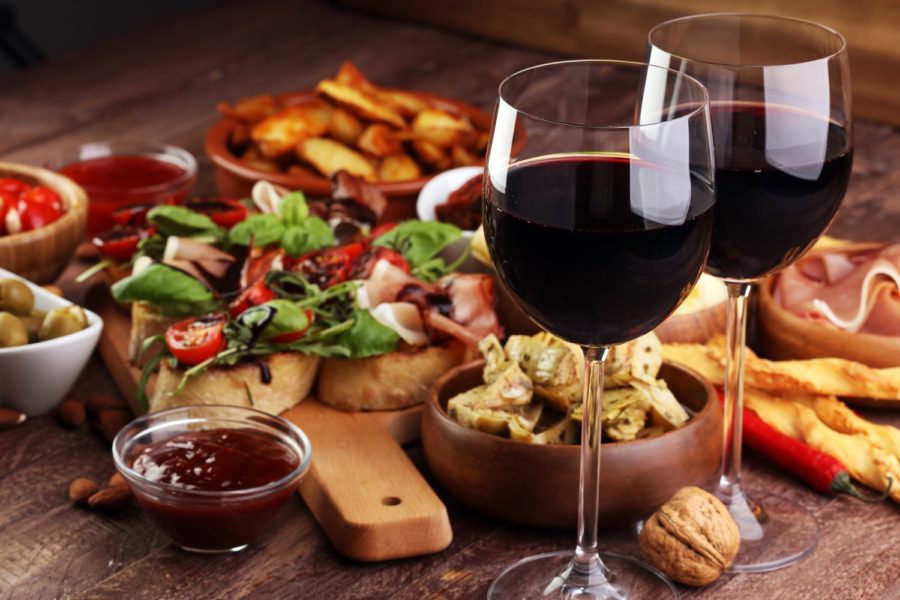
11 Basic Rules Of Food And Wine Pairings
Having second thoughts on what kind of wine to serve for your next family gathering? Well, that’s understandable, especially if you’re new to wines. Wine ranges from red to white wines, and it’s made from different kinds of grapes. Varieties include pinot grit, Chardonnay, and Shiraz, which are produced by renowned wineries all over the world.
Wine, as classy as it comes, can be tricky to consume. Its luxurious taste is drawn out only when paired with the right food. This is because wines are complementary drinks. They either complement a dish or enhance it. Moreover, they’re not only sold in big bottles but also available in smaller bottles, which you can get from online wine sellers like Usual Wines. You can begin your wine connoisseur journey by learning the basic rules of food and wine pairings.
1. Similar Weight
Weight in this context refers to the pairing of wine and food. It doesn’t pertain to numeric figures but the ‘feel’ of the wine and the dishes. In matching wine weight to food, follow light to light and heavy to heavy. Light wines such as white wine and low-tannin reds are delicate. Light food ranges from poultry to fish.
On the other hand, heavy wines complement richer food. For example, prawns and Chardonnay are both medium-weight and rich; therefore, they complement each other. For heavier dishes like red meat casseroles, they’re best complemented with full-bodied wines like shiraz.
2. Intensity Of Flavor And Character
In pairing wine and food, remember that similarities in the flavors complement each other. An excellent example of this is fish with lemon sauce, which is best paired with a wine like pinot gris. Having the citrusy taste as their common ground, they could both work well together.
Just like the weight, learn to match wine and food based on their intensity. Pair mild wine with mild food and flavorful wine with flavorful food. A spicy, bold shiraz is an excellent pair for heavily seasoned meat like pepper steak. Consequently, match the level of richness—chicken doused in cream sauce will do great with Chardonnay.
3. Acidity
Consider the acidity when choosing pairs. High-acid wines are often used to clean the palate after eating oily food like curry or any dish with buttery sauces. Riesling wine is a good example of this. If the dish has acidic content, it’s recommended to pair it up with a crisp, dry pinot grigio. Most wines produced in cool climates will have more acidity than those from areas with hot weather. Note that rich, creamy sauces will often clash with an acidic wine like sparkling wine. Just imagine drinking milk mixed with lemon juice.
4. Salt And Tannin
In the act of balancing flavors, salty food goes well with crisp and acidic wine. Sauvignon blanc with salty olives and feta cheese is a perfect example of balance. However, a bit of sweetness can also enhance and balance salty food.
The same principle applies to wine: a sweet Sauternes, made in the Bordeaux region, is often paired with salty Roquefort cheese, but if you want wine that’s not as sweet, such as pinot gris, then that can also work. However, grippy red wines such as cabernet sauvignon and shiraz can clash with salt, making the tannin seem sharper, so do avoid those.
Wines with noticeable acidity and low tannins work better with salty food than dry wine. If you have some hard or partially hard cheese and would like to pair it with wine, some good Chardonnay will work well.

Italian antipasti wine snacks set. Cheese variety, Mediterranean olives, pickles, Prosciutto di Parma, tomatoes, artichokes and wine in glasses over black grunge background
5. Mirroring And Contrasting
When pairing food and wine, you can choose to mirror or contrast their flavors. One example of mirroring is Chardonnay with lobster in cream sauce. Their main ingredients are the perfect match because both are abundant and creamy.
On the other hand, you can do the opposite of mirroring, which is the contrasting method. Contrasting is doing the exact opposite for juxtaposition. Try pairing lobster in cream sauce with champagne, which will give you a lustrous, delicate, and sharp sensation through the bubbles in it. This could be an excellent option for your next wine dinner.
6. Bitter Tannins With Heavier Food
Tannins have been mentioned a couple of times, but what exactly are they? Tannins can come from the skins of grapes used in winemaking. They may also be present in other places, such as the wood barrels where wines are fermented. If you’ve tried tasting a used teabag, the bitter taste is due to tannins. It’s not actually foul, but it leaves a strong impression. The astringent flavor tannins give helps in cleansing the palate after a heavy, rich meal. For this reason, a cabernet sauvignon and shiraz would work well with steak dishes.
7. Wine As Sweet As The Food
Always serve wine that’s at least as sweet, if not sweeter, than the food served—that’s the general rule of thumb. Sweet wines, like Sauternes, have a good level of acidity. This makes them an excellent match for rich dishes like pâté and steaks.
On the other hand, sweet food makes dry wines taste over-acidic and tart. The level of acidity will cut through the fat in rich dishes, and the wine’s sweetness will complement the food’s rich flavor. Moreover, the sweetness will balance the salt level. This is the primary reason why sweet wines are the preferred classic pair for blue cheese.
8. Spicy Foods Matches Spicy Wine
Can’t keep up with the spice in your food? Flush it out with sweet wines. These offer relief from spicy ingredients such as chili peppers, which can clash with and ruin the flavor of most wines. More often than not, wine isn’t the ideal choice to go for when trying to recover from spicy food—that’s more like the job of milk. However, if you still want to pair wine with spicy food, then opt for something sweet to match the spice, like a bottle of Gewürztraminer or Riesling.
9. Fruity Wines For Fruity Dishes
As the old saying goes, birds with the same feather flock together. The same reasoning applies to wines. In pairing wine and food, choose fruity wines with fruity dishes. Gewürztraminer, muscat, Riesling, and viognier are the common options for fruity wines. As for the dishes, one can have pork with sautéed apples, roasted chicken or turkey with apricot glaze, duck with figs, and similar fare. Fruit-driven wines emit fragrant aromas that complement fruity dishes.
10. Umami
Wine can complement dishes with umami, the so-called ‘fifth taste.’ Ingredients such as Parmigiano-Reggiano cheese, soy sauce, wild mushrooms, and most red meats are used by chefs to craft a dish that would be splendid with wine. A perfect match would be a dish like steak and some cabernet sauvignon. If you want a punchier taste, then add some grilled mushrooms, which will surely hit the spot.
11. Pair With The Sauce
Congruent and complementary pairing techniques can be used when pairing wine to the sauce of a dish. Pair citrusy sauces with chardonnay and sauvignon blanc, and pair red meat with shiraz.
Conclusion
Wine is a truly timeless drink. Its exquisite, classy taste is sought worldwide by those who want to experience extravagance and finesse when dining. Take your pick of the best wines and allow them to make your meals more special than ever before.









